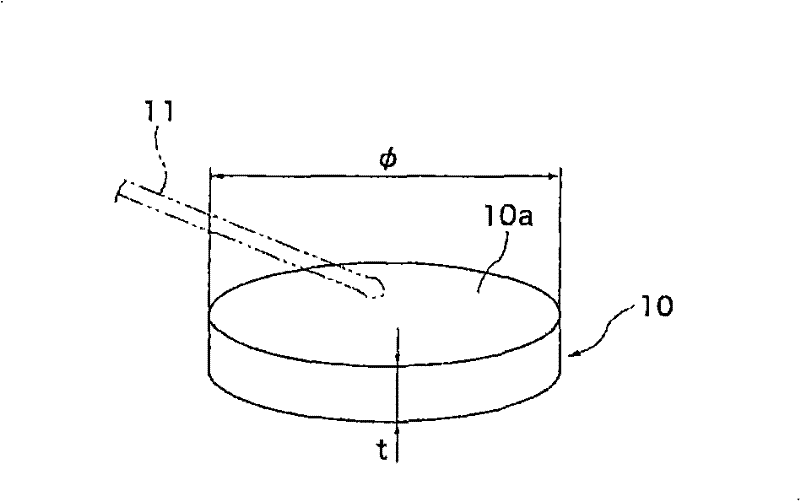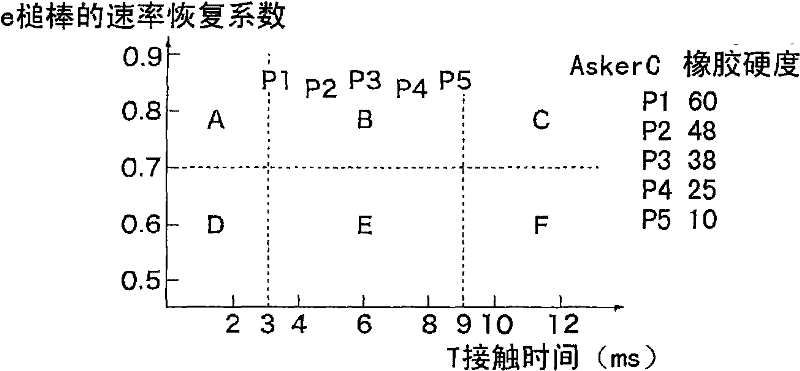Drum pad
A drum pad and rubber technology, applied in percussion instruments, instruments, electro-acoustic instruments, etc., can solve the problems of difficult to achieve drum pads, unable to obtain rebound touch, etc., to enhance the coefficient of restitution, reduce inertial mass, and reduce pain. Effect
- Summary
- Abstract
- Description
- Claims
- Application Information
AI Technical Summary
Problems solved by technology
Method used
Image
Examples
example 1
[0073] In Example 1, the manufactured diameter A drum pad 10 with a diameter of 260 mm and a thickness t of 20 mm was used as a sample. The foam material used is foamed silicone RTV rubber. Two-liquid RTV rubber KE521 (A / B) (trademark) manufactured by Shin Etsu Silicon Co., Ltd. was used.
[0074] FIG. 3( a ) is a diagram schematically showing a process of manufacturing the drum pad 10 according to Example 1. FIG.
[0075] First, liquid material A and liquid material B of KE521 weighing about 250 g (a total of half the volume of the mold 20) were weighed and mixed well. Then, as shown in Figure 3(a), the mixed materials A and B are injected into the inner diameter 260mm, thickness t1 is equal to the thickness t (20mm) of the mold 20, and the mold 20 is closed. At this time, the thickness t0 of the mixed material 12 was 10 mm. When the mold is left at room temperature for about 10 minutes, gelation begins, viscosity increases, foaming begins, and therefore volume increas...
example 2
[0091] The shape of the drum pad 10 manufactured according to Example 2 was the same as that of the drum pad 10 of Example 1. Materials used as the foam material are rubber materials mainly including BR (butadiene rubber) and NR (natural rubber). The mixing ratio of the rubber material is as follows: as an additive material of 60wt% of BR and 40wt% of NR, zinc oxide is 3wt%, stearic acid is 1wt%, sulfur is 6wt%, calcium carbide is 15wt%, carbon 10 wt%, and blowing agent (for example, 4,4'-OxybisBenzene Sulfonyl Hydrazide (4,4'-OxybisBenzene Sulfonyl Hydrazide) (its decomposition temperature is 160° C.)) is 4 wt%, as additive materials. These materials are stirred by using rollers to produce a compound.
[0092] 4( a ) and FIG. 4( b ) are diagrams schematically showing the process of manufacturing the drum pad 10 according to Example 2. FIG. First, as shown in FIG. 4(a), the produced compound is put into the first mold 21, pressed (press) at 130° C. for 7 minutes, and vulcani...
PUM
 Login to View More
Login to View More Abstract
Description
Claims
Application Information
 Login to View More
Login to View More - R&D
- Intellectual Property
- Life Sciences
- Materials
- Tech Scout
- Unparalleled Data Quality
- Higher Quality Content
- 60% Fewer Hallucinations
Browse by: Latest US Patents, China's latest patents, Technical Efficacy Thesaurus, Application Domain, Technology Topic, Popular Technical Reports.
© 2025 PatSnap. All rights reserved.Legal|Privacy policy|Modern Slavery Act Transparency Statement|Sitemap|About US| Contact US: help@patsnap.com



